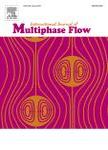版权所有:内蒙古大学图书馆 技术提供:维普资讯• 智图
内蒙古自治区呼和浩特市赛罕区大学西街235号 邮编: 010021

作者机构:Beijing Inst Technol Sch Mech Engn Beijing Peoples R China
出 版 物:《INTERNATIONAL JOURNAL OF MULTIPHASE FLOW》 (国际多相流杂志)
年 卷 期:2021年第142卷
页 面:103690-103690页
核心收录:
学科分类:080704[工学-流体机械及工程] 080103[工学-流体力学] 08[工学] 0807[工学-动力工程及工程热物理] 0801[工学-力学(可授工学、理学学位)]
基 金:National Natural Science Foundation of China [51839001, 51909002, 52079004] Beijing Natural Science Foundation [3204056, 3212023] Defense Industrial Technology Development Program [JCKY2018203B025]
主 题:Unsteady sheet cloud cavitation Cavitation dynamics Fluid-structure interaction POD DMD
摘 要:The objective of this paper is to study sheet/cloud cavitation dynamics in fluid-structure interaction by experimental and numerical methods. The high-speed camera is applied to observe the cavitating flow structures and the Laser Doppler Vibrometer is used to characterize the vibration. A hydrodynamic load cell is applied to measure the lift and drag static force. The results present different cavitating patterns of the flexible hydrofoil and the vibration amplitude is enhanced when the cloud cavitation occurs. The hybrid coupled fluid structure algorithm is adopted to simulate the cloud cavity shedding downstream due to the re-entrant jet from the cavity closure to the hydrofoil s leading edge. The vibration analysis shows that the frequency spectrum of the flexible hydrofoil is much more complicated than the rigid one, the main cavitating flow-induced vibration frequency of the flexible hydrofoil is due to the cavity shedding, others are corresponding to vortex shedding frequency and natural frequency in water. The Proper Orthogonal Decomposition (POD) and Dynamic Mode Decomposition (DMD) methods are used to investigate the dominant coherent structures of the cavitating flow. With the POD method, it reveals that large-scale cloud cavities occupy a large amount of energy in the flow field. The DMD method accurately extracts the dominant frequency and modal characteristic, with the first mode corresponding to the mean flow field, the second mode being cavity shedding and the third and fourth mode being vortex shedding. (c) 2021 Elsevier Ltd. All rights reserved.